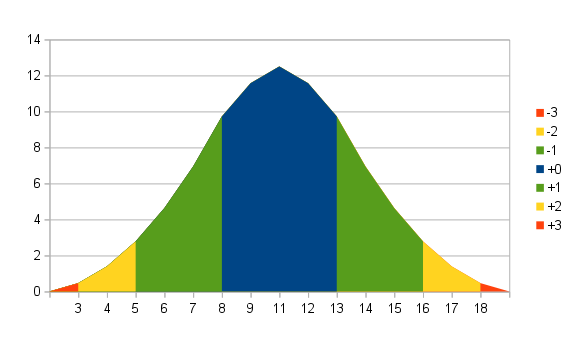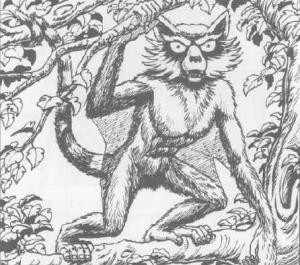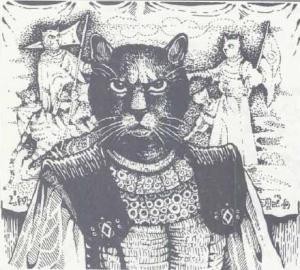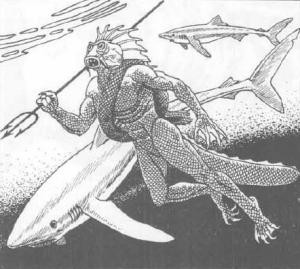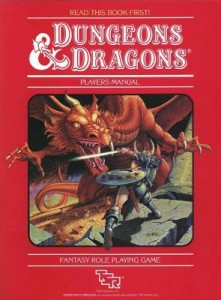Surprise, as it is explained in Dungeons & Dragons throughout almost all editions is a bit weird. In the TSR editions, it is usually explained that in the case of an encounter, both the players and the (potential) enemies roll a d6. On a roll of 1 or 2 they are not surprised, on a roll of 3-6 they are. If both sides or neither side is suprised, initiative is rolled to see which side goes first. If one side is surprised but the other is not, then the side that is not surprised gets to act in the first round and the other is not. After that round initiative is rolled as usual.
3rd edition ditched the d6 roll and only mentions in passing that a Spot or Listen skill check might be used to determine awareness, but it also explicitly calls the begining of the encounter a Surprise Round.
But when you think about how awareness and surprise would work outside of game mechanics, it doesn’t really make much sense. The flaw here is that the rules make it sound as if you have two groups running straight into each other and one realizes a bit faster what is going on than the other group.

But why does the group that has surprise only get one round during which the other side is still inactive? If you become aware of the other group before they do, you usually still have the option to not make your presence known to them immediately. If you are opening a door in a dungeon and there is an enemy on the other side, then yes. They may be surprised, but after the initial shock they would immediatly jump up and go for their weapons.
But unless you play a simple Hack & Slash game, that’s not what you’d usually be doing. You can become aware of another group before you are standing face to face. You silently creep through the dark corridor and reach a cave where an ogre is chewing on human meat with his back turned towards you. You hear voices talking around the corner or you might see the light of a lamp approaching from behind a bend in the corridor. In these situations you still have some time to extinguish all lights, find hiding spots, or run away before you are noticed at all. Depending on the distance you might still have a lot of time to prepare for battle. Once you jump out of your hiding places, then you are getting your surprise round during which the other group can not take any action.

Of all the editions of D&D I have here, only the Rules Cyclopedia even mentions this at all.
When one party is surprised, the unsurprised party notices the surprised party at the 1d4x10 (feet indoors, yards outdoors) distance rolled; the surprised party won’t notice the unsurprised party until they reach half that distance.
Thanks, Aaron Allston. If this was your own houserule, it’s a really good one. Maybe it had always been asumed, but to my knowledge it has never been explained like this anywhere else. Using this rule also makes a huge difference for thieves at low levels. Sneaking up on a guard to backstab it with 20% to Move Silently at 1st level is just suicidial. Nobody would ever do that, especially when you only have 1d4 hit points yourself. In combination with a surprise system that lets you turn around and back off to a distance outside the encounter distance, 20% is something to actually consider.
Imagine a the maximum encounter distance of 40 feet inside a dungeon. Both the thief and the monster make their surprise roll at 40 and if they are both surprised, they will notice each other at 20 feet. If the thief is succesfully Moving Silently, he will automatically detect the monster at 20 feet, but the monster will not notice him at either 40 or 20 feet. If the rest of the PCs stay 25 feet behind the thief, the thief will reach auto detect distance to the monster before the main party reaches possible detection range. The thief then can give a hand signal to the other or return back to them and tell them what he saw. Then the entire party knows the monster is there, make a descision whether to approach or not, and if they do they will have surprise on their side. The monster still has to roll surprise again to see if it will notice the party at full encounter distance or half encounter distance (which might be as close as 5 feet on the roll of a 1 on the d4). Even if the Move Silently roll fails, there is still chance to get regular surprise on the monster and the thieves friends are right behind him. It’s a lot less stupid than trying to walk up to a monster that might know you’re walking straight into the reach of its attack.
This is another one of these cases where an odd old rule mostely went ignored for being irrelevant though it does serve an important function: Encounter Distances. You don’t have to roll it and you could always decide on an appropriate value yourself, but any surprise system worth using should have the option to retreat undetected or prepare an ambush. Just a single free round of action before combat automatically starts isn’t cutting it.

